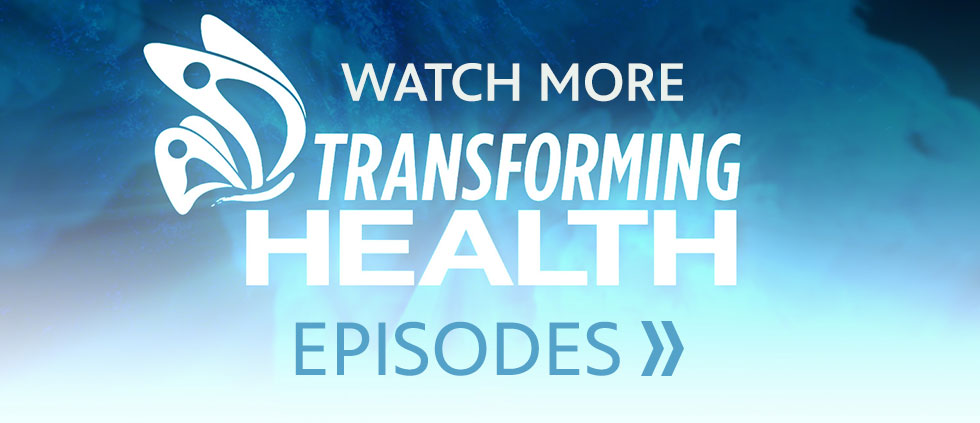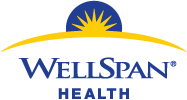Finding Calm in the Chaos
The COVID-19 pandemic is like nothing we’ve experienced. We are all dealing with stress and uncertainty in one way or another. During times like these, experts say practicing mindfulness can be a way to find calm in the chaos.
I’m worried. I have no control. I don’t know what’s going to happen. If you’ve had any of these thoughts, you’re not alone. The coronavirus pandemic has created uncertainty and stress for everyone. Maybe the most difficult part is that we don’t know how long we’ll have to live with it.
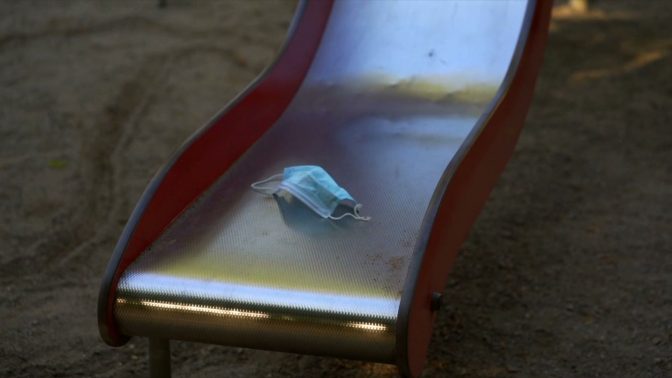
It’s challenging. It’s challenging. All this change, you know, and all this unknown. So, I guess just taking it day by day.
I’m trying to work fulltime. Maintain my recovery. Maintain my sanity. Be a mother. Homeschool my kids. Get their work done so they don’t fall behind. And just kind of manage through the day.
Our daughter is getting ready to go off to college here on Friday. So there’s that kind of natural excitement for her, for the next changer. And also just kind of just wanting to make sure that she’s gonna be okay.
Getting ready to head into work for a regular day at the hospital. But a regular day at the hospital could mean a whole lot of things. Hi. Here’s one of the munchkins. Good morning. How are you? Mommy has to go to work today, okay?
So how can we find calm in the chaos? For some, practicing mindfulness has been a way to regain control in their lives.
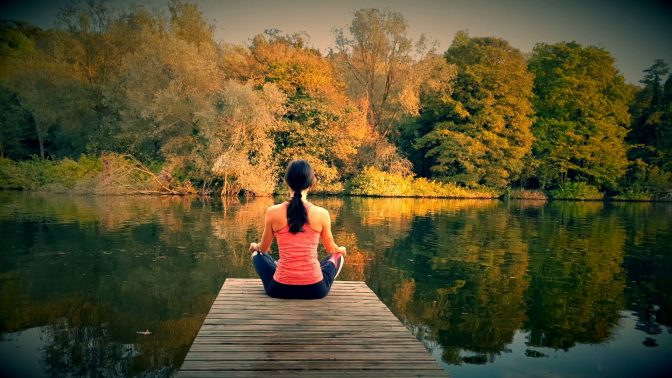 We often think about mindfulness as a practice, but mindfulness is actually more of an attitude or a way of being in the world. The most commonly used definition is one from Jon Kabat-Zinn, one of the original people to bring secular mindfulness to the west, really. His definition for mindfulness is quite simple, it’s — “paying attention, on purpose, non-judgmentally and in the present moment.”
We often think about mindfulness as a practice, but mindfulness is actually more of an attitude or a way of being in the world. The most commonly used definition is one from Jon Kabat-Zinn, one of the original people to bring secular mindfulness to the west, really. His definition for mindfulness is quite simple, it’s — “paying attention, on purpose, non-judgmentally and in the present moment.”
At its core, mindfulness truly is, can I slow down and be in the moment right here, and just be present without judgement.
Mindfulness is such a vital tool during the 2020 pandemic. I can’t imagine something that we all need more right now than mindfulness, because we are all dealing at least a little bit with a bit of trauma. A little bit of lack of control over what is happening to us. And I think the ability to take that back, to build a skill that allows for us to care for ourselves, is the very least that we could be giving to ourselves during such a difficult time.
Today, healthcare is about empowering people to take control of their health. Whether creating a fitness routine, choosing the right procedures and medications, or adhering to treatment for a chronic condition. Capital BlueCross. Dedicated to underwriting “Transforming Health” for the good health of the community. WellSpan Health. Helping patients reach their health goals through a coordinated system of physicians, hospitals, and convenient healthcare services in communities across central Pennsylvania. Learn more a wellspan.org. WellSpan Health. For the journey that is life. Support also comes from viewers like you. Thank you.
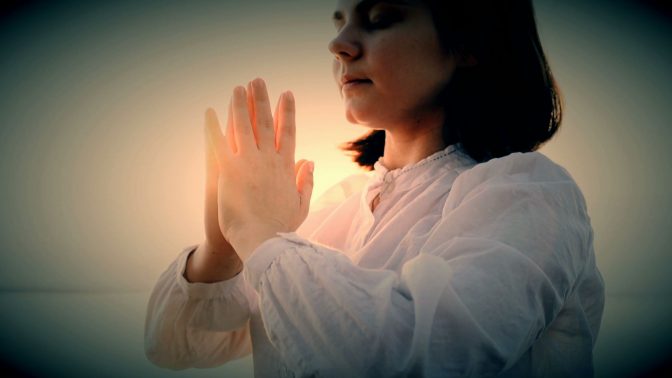 Hello, and welcome to “Transforming Health: Finding Calm in the Chaos.” I’m Keira McGuire. Over the next half hour you’ll meet three people who have found a place in their lives for the practice of mindfulness. They’ll share their thoughts on how it could help us all find peace during these challenging times.
Hello, and welcome to “Transforming Health: Finding Calm in the Chaos.” I’m Keira McGuire. Over the next half hour you’ll meet three people who have found a place in their lives for the practice of mindfulness. They’ll share their thoughts on how it could help us all find peace during these challenging times.
My name is Sebrina. I’m actually from Eugene, Oregon, which is kind of, um, you’d say — many people would think of it as kind of a hippie-ish place. There were a lot of people around me that did, you know, mindfulness, meditation, yoga, and all this other kind of stuff. And I’m gonna just be completely honest, and say that I thought it was garbage.
So when did you begin to reconsider the idea of mindfulness.
So when I came to Penn state, I actually begrudgingly got involved with a brand new research project.
I was struck by the transformation for some of these teachers over the course of the training. I started engaging in the practices. Both during the workshop, just to see what it was like, but then also I started carrying little pieces of it with me. And I would just say that I think I have more life in my life now than I had before.
So we’re gonna do an activity right now where I’m going to ask you to spend just a few minutes writing or thinking about an experience of anger that you’ve had recently. We did a webinar with the Pennsylvania state education association. The first webinar we did was the middle of April. And we started out with enough, you know, “space” — right? Virtual space. For 500 people and that wound up not being enough.
So I decided to get up a little early this morning before everybody else was awake to take a little bit of time for myself and just reflect on what the day has in store for me. One of the practices I really like doing, especially in the morning, is intention setting. So, just thinking about how I want to be in this day today, not necessarily what I need to do. So like, for example, my intention for today is to take things one at a time. I have a lot on my plate right now. And so, you know, if I instead focus on just being present with whatever’s right in front of me, I find that it can be really helpful. So, it’s about 2:00 in the afternoon and I’m just getting ready to sit down and do a couple of minutes of meditation. Some mindfulness practice. I’ve gotten about 40 emails today, a handful of which were rather emotionally provocative. And so — one of the things that is kind of hard about doing these things right now is that, of course, being in my home, and having everybody else home, means I often have other distractions. Like my dog barking at the mailman, or one of the kids coming home, or my husband walking by. So I have my handy dandy noise cancelling headphones. Sometimes it just helps to put them on and remind myself that I’m here and present in this space to try and help myself in this moment. So I’m here on my couch, where I’ve been for most of the day today. This is my other office space here at home, in the current situation that we find ourselves in. Everybody working from home. I spent most of the day today looking over upcoming trainings for the care program. We often forget that the best thing we can do, in order to take care of the kids who are in our schools, is to make sure that we’re okay. I’m just really grateful that I get to do this work and that I get to help continue to promote this program and promote this kind of — these kinds of skills in other people.
Sebrina, in this time of uncertainty, how do you think mindfulness could be beneficial to others?
I think the biggest opportunity is just noticing that we all have choices. And that as much as it can feel overwhelming, and like we don’t, right? But to realize that you have the opportunity, even in just the choice of how you’re going to engage with your day. You know, how you’re going to choose to be with all of the stuff you have to do, that idea of choicefulness in that moment can be really important. I can’t control my situation, but I can control my reaction.
Hi. My name is Allison Keith and I am a seventh grade English teacher. Hey. Good, I’m doing good. How about you?
As a teacher, how have you been impacted by the COVID-19 pandemic so far.
Our school is a title I school, which means, sort of in lay terms, that we work with primarily students who are from economically disadvantaged backgrounds. And there was a ton of trauma that our students were experiencing as a result of the pandemic. When you’re hearing story after story of student who has a family member that is ill. Or story after story of a family who is in economic distress, right, because a parent had lost their job. Or a student who is worried, right? That’s a lot on us, and being able to process those emotions ourselves to make space for being able to take care of others is really critical. There was also kind of a big shift in terms of, sort of, our role as cyber and distance learning educators, because suddenly we were in the spotlight. And we’re used to kind of being a little bit more in the background of education. I had started a podcast with the history teacher on my team where we had brought on teachers in brick and mortar schools who were doing really cool, really innovative pedagogy.
Hello, everyone, and welcome to our pandemic pedagogy episode. As we mentioned in our last episode, we have been sort of really overwhelmed and very touched, and sort of emboldened in the faith that many of you have placed in us, asking for some help, some tips, some tricks.
We had probably 200, I think, views on all of our episodes at the beginning. And then once the pandemic started, we suddenly started seeing those kind of numbers daily for a really long period of time.
I actually went and moved from this lovely apartment, where I live right now, and moved in with my mother. She had become sick right at the beginning of COVID-19, and we weren’t sure for a while, because testing was a little inconsistent. We weren’t sure whether or not she was sick with actual COVID. And so I think there was a lot of additional stress that came from caring for a lot of people. Right? When you’re care for family members, when you’re caring for other students. But also when you’re sort of becoming a bit of a nexus, right, for other teachers who are asking questions, and that need help and that need support. And that begins to show up, right, in our ability to show up for other people. It comes sort of down the line. And I think the thing that really helped me was that I did have a community of educators at my school who had all gone through the same mindfulness training that I had gone through. I first met Sebrina at a retreat where she was the mindfulness certified educator. Her training was in February of 2020. Obviously sort of really before the pandemic had launched up. And I know in the beginning, I was invited to go, and I really had some big misconceptions about what mindfulness actually was. I thought of mindfulness as this thing that was about rest and relaxation, which is antithetical to so many teachers I know. Like most especially me. And I think what I found in the course of actually doing this training was that mindfulness can exist in rest and relaxation, but mindfulness is a skill, and it’s a thread you should pull on throughout your entire day. So the educators that I left with, and I decided that we were going to work together to try to practice together. And I expected it to be helpful. I certainly expected it to build comradery. What I did not expect was how much a sustained practice was going to bring to my life.
Good morning. It is bright and early. 6:45. And I am about to take you on a virtual tour of my day as a mindful virtual educator. So I’m glad to have you on the ride today. So I start every day the same way, which is sitting down with a cup of coffee to plan out my day. Now this is the most important part of my day, because it’s where I plan my intention for the day. During the school year, I would take that intention and put it in a group chat with fellow educators, but it’s still the summer. So they’re not necessarily in line, nor should they be, and I’m going to take my intention instead and put it into my digital planner. That way I still have a record to reflect on later. Our day is still pretty busy, even though it’s not an official school day, ’cause there’s so much to get ready. This morning, I am meeting with my podcast host and a brick and mortar teacher from a local school distract. And we’re going to be talking about how to use sort of zoom and web conferencing software to bring the world into your digital classrooms. And the rest of my day is just getting ready for the students. So I have welcome videos to make. I have assignments to get set up. Basically everything so that the year has a really smooth start for them when they get going. I have a tendency to be a little bit of a perfectionist about this kind of stuff, so I want to make sure that I’m getting everything done that I have set to do, even if it’s not necessarily perfect. So I think that’s going to be my intention, is that really for today, just focus on getting everything done. Be unattached from that outcome, right? It doesn’t have to be perfect, it just has to be finished. So now that I’ve planned my day, I’m ready to go ahead and enter my office. And we’re gonna get started with my meditation practice. So I set a goal for myself at the beginning of last year that I was going to meditate at least one minute every single day. And the reason behind the one minute was there should never be a day where I can’t make one minute’s worth of time for myself. I do a particular method, which I’m going to go ahead and show you here, which is called grounding through the senses. And basically what it does is it sort of brings you to the present moment using your sense as a method to keep you present. I use a candle to help me get started with this. So I’m going to go ahead and light my beautiful candle. And I can already kind of smell sort of the perfume that is coming off it. I always make sure to use a scented candle and I’ll sit cross-legged. And I’ll begin to go ahead and meditate. So I’ll usually start by thinking a little bit about the sounds that I’m hearing, the smells that I’m smelling. Sort of using that candle as a way to enter the rest of my sensory experience. And just try to focus on being very present in the moment and using my sense as a way to kind of pull me back. And if other feelings arise, that’s cool. That’s natural. You just kind of let them be there and float on by. Often it’s more than one minute every day. I’m up to about five minutes, but one minute is sort of the minimum that I ask for myself every day. And it’s honestly made a big difference. Hello, it is five o’clock. I am mostly done with my day. I have one lonely assignment that I have to finish up a little bit later tonight. It was a good day for the most part. I did manage to get an awful lot done. I had to change a lot about my opening of year assignments though. There were a lot of questions and activities that in a normal year might have seemed sort of, really, benign. Questions like, “what did you do with your summer?” that, this year had a little bit of bite behind them potentially for students. Right, we really try to be trauma informed about our practices and I know for a fact that I will have students whose parents were laid off during this summer. Students who, either they or people that they know, got sick. And so I want to make sure that my assignments as a teacher, right, are helpful and forward thinking and giving students a place to feel kind of safe and some regularity and some normalcy in their day, when they come to school. So, I’m excited for that. I’m about to start dinner pretty shortly, which is one of my favorite other mindful activities. I used to be the kind of person that would cook listening to music or a podcast, and any more, I just kind of like to enjoy the quiet and just sort of focusing on the cooking and the natural sounds and rhythms.
Allison, you’ve been practicing mindfulness for some time now. Would you say it could be beneficial for others right now?
I think that mindfulness gives us the power to feel like we have some control over our own minds and over our own emotions, right? The practice of mindfulness isn’t going to change any of the things you’re experiencing in your day to day. Right? It’s not going to take something that is sad and make it not sad. It’s not going to take something that is stressful and make it not stressful. What mindfulness is going to do for you is allow you to recognize in the moment that that’s what’s happening. I honestly think it’s changed so much about my quality of life. Literally, just a couple weeks ago, over the summer, I was on a walk with my boyfriend. We were taking a hike, one of the few things you can do right now that’s safe, right? And I found myself getting really stressed about the beginning of this school year. There was a ton of work that I knew that I needed to do. As soon as we were done this hike, I knew that I had to go back and really get started. And I wasn’t present with a person that I loved because I was so focused on stress and the thing that happened in that moment that was so powerful was that I noticed that thought. I noticed that I wasn’t having the experience that I wanted to have in a beautiful place with a person that I care deeply about, right? And I was able to notice that thought and then I was able to use that same process of grounding through the senses. Take a deep breath. Smell those pine trees. What do I hear? Do I feel the gravel under my feet, right? And I was able to not just notice that there was a problem, but I actually had a solution for how I could bring myself back to that moment and put in place a compassionate boundary with myself. That work needed to be done, but I don’t have to be stressed in that moment. I can be focused on this experience and giving something back to myself. I think my advice to someone who’s maybe feeling skeptical is that it can’t hurt to give 60 seconds of your day to something that could change your life.
Hi, I’m Mike Diller. I am a licensed psychologist and I’m also the director of WellSpan’s employee assistance program or EAP.
So, how has your life changed since the start of the COVID-19 pandemic.
March 13th was the last day I was in my office. Within five days, we went completely virtual, worked from home, my whole team picked up, moved, went home and we’re still here. As this continues to draw out longer with no clear definitive end point, I know all of us want — when is this going to be done so we cans tart the rebuilding and the recovery process. And we don’t have that, so that uncertainty creates a lot of stress in all of us. It impacts all of us no matter who we are. Certainly, for me, it’s been challenging because I am someone who loves to be with people in person, fist bumps, handshakes, hugs. I love doing that, and haven’t been able to do that for five months. And sometimes people will say, well how do you handle that mike? You’re the professional. You’re the psychologist. And I’m like, the underlying piece of all of this is that I’m human just like you are. And so, there are moments that I struggle as well. It can happen to any one of us. You know, where we, you know, get up any given day or part of the day and we realize, my gosh, there’s a lot going on. There’s a lot going on, perhaps on the personal side of things. There’s a lot going on, on the work side of things. Socially, there could be many different things happening. And at times it’s easy to get caught up in to — I call that the whirlwind of life that can happen to all of us. If I’m working out and I’m on a treadmill and I just keep hitting increase the speed, the rpms and I don’t ever take time to slow down, there’s going to be a time that I’m not going to be able to sustain that. So mindfulness allows us to kind of slow down the speed and then to a place where we can just be able to focus in the moment without judgement and give the body and the mind a chance to kind of rest. And almost, in some ways, kind of rejuvenate, recuperate.
Good morning. It is the start of my day and that day usually starts anywhere from 6 o’clock in the morning to 7 o’clock in the morning. Getting up, getting ready and my office is really still here in my house. For the last five months or so since the pandemic unfolded, and so this is my work setting now. Any given day I have a schedule. Every morning I sit down and I try to ground myself, saying, “okay.” let’s write the priorities of the day. What do I need to get done. What must be done today? So, I’m setting myself up for the day and I look at my schedule, and I see I have to get to an appointment in really, not too far away here, and that appointment has nothing to do with work. My daughter, who’s going to college this Friday, she had wisdom teeth taken out and she developed an infection over the weekend. Had to see the surgeon over the weekend and today is the follow up appointment. Why do I share that with you? Because no matter what I have on my schedule, no matter what’s going on in my professional life, there’s always a personal life that’s going at the same time. And so, that can be stressful. So that’s the start of my day. Really, when I take a breath, because it’s important to do that, I think about setting the day and the mindset is, how can I be helpful today? And when I get back from this appointment the day will continue, meetings will happen, and good things will get done. Hello again, back from the dental appointment with my daughter. Everything worked out with the surgeon. She seems to be on the mend. And now I’m back, back at work, getting ready for a meeting called check and connect. So this is my team right here. Two times a week, we get together and we do it virtually. Then we check in with each other and we just kind of see just where things are. How are they doing? How are we doing? And it’s not just about just work related responsibilities and issues and tasks. It’s also about just, kind of, whatever else is going on in their life. So, it is getting close to dusk right now and we’re looking to just take a moment to pause and slow things down here. My partner in life, my wife, Ilsa, we’ve been walking and just taking some time together. And one of the other things that I love doing, my team knows this of me as well, is that at times just being able to just stop, take some deep breaths, especially on a day where, you know, it may have been a bit of a whirlwind and sometimes between our personal lives and our professional lives it gets to be that way. And then just look up, look up at the sky and be able to take it all in and — so when you look above me now — it’s a beautiful sky, sunset in the horizon behind me. One last check in here for the day. It’s getting a little bit late here in the evening and as I start off each day trying to think, how will I be helpful today, what will I contribute to the day? At the end of the day I think about, how have I been helpful and what am I grateful for? So, here we are, and end of a day. It was a good day and I thank you for being able to follow along and share with me some of those moments in a day in a life. So, I wish you well during this time as we continue to stay together, work together, and get through this pandemic crisis with COVID-19. And we will, and that’s my own self talk at times too, that this will end, in terms of, it will not be permanent and we’ll get through this together. So be safe and be well and take care.
I’d like to thank all of our participants for sharing their thoughts and experiences so openly. We hope these stories have provided you with a bit of calm in the chaos. Be well and join us next time as we continue to share stories and transform health. I’m Kiera mcguire. Thanks for watching.
Today, healthcare is about empowering people to take control of their health. Whether creating a fitness routine, choosing the right procedures and medications, or adhering to treatment for a chronic condition. Capital BlueCross, dedicated to underwriting Transforming Health for the good health of he community. WellSpan Health, helping patients reach their health goals through a coordinated system of physicians, hospitals and convenient healthcare services in communities across central Pennsylvania. Learn more at wellspan.org. WellSpan Health, for the journey that is life. Support also comes from viewers like you. Thank you.
Keira McGuire is a health reporter and multimedia producer for WITF. She hosts and produces Transforming Health television programs as well as other shows and documentaries for WITF’s Original Productions. McGuire produced the Emmy Award winning series HealthSmart for the last ten years. Keira previously worked at WBFF in Baltimore and WMDT in Salisbury as a reporter and anchor. She’s a graduate of Towson University.

